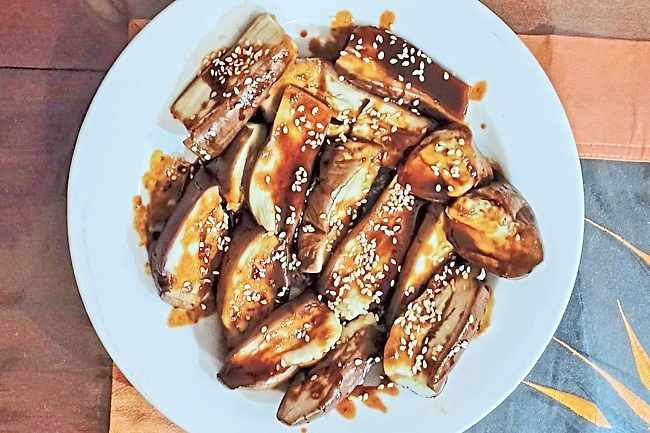ANN/THE STAR – Eggplant, known by various names such as brinjal or aubergine, offers a consistent taste regardless of what you call it. Once cooked, it transforms into a soft, almost mushy texture. Initially, my children disliked it.
However, as one matures, tastes and preferences evolve.
This was the case with eggplant in our household, transitioning from a despised vegetable (technically a fruit) to a sought-after ingredient. Interestingly, my children now enjoy both eggplant and the jiggly char siew.
I found this transition pleasing, especially considering eggplant’s longer shelf life compared to leafy greens in the fridge.
Additionally, I stumbled upon the convenience of steaming it using the microwave.
If you’re cooking more than two eggplants, then steaming this in a larger wok makes more sense. But if it’s just a small side dish for two people, it’s easy enough to steam this in the microwave.

Arrange the eggplant in a steamer that’s microwave-friendly, pop it into the microwave at high power for about four to five minutes until it’s cooked. For me, it means fewer dishes to wash!
The ingredients for the sauce may seem complicated, but it’s really just a mash-up of the condiments found in my kitchen.
The sauce recipe is very flexible – you may want to add other things like dark soy sauce, oyster sauce and/or fish sauce, or use gochujang instead of miso, or omit it altogether.
The taste I’m aiming for is sweet salty, with a just hint of sour, and the miso gives it that bit of umami.
To avoid the eggplant from turning brown after steaming, you can soak it for three minutes in diluted vinegar or salt water before steaming.
But then, this would mean it’s a three-step dish; since it’s just us eating this at home and I’m lazy that way, I skip this.
The whole idea is that you don’t have to heat up anything (you may choose to fry the garlic if you like, and cook the sauce over the stove if you prefer it sizzling hot over the eggplant) apart from steaming. Just mix the sauce and drizzle over the eggplant.
Pretty up the dish with the toppings and voila, you’re done!
INGREDIENTS
Two long Chinese eggplants (approximately 400g)
Sauce
– One teaspoon miso paste
– Two tablespoons light soya sauce
– One tablespoon black vinegar
– One teaspoon rice vinegar (or lemon juice)
– One tablespoon white sugar (or to taste)
– One tablespoon honey
– One tablespoon sesame oil
– Dash of white pepper
– Three garlic cloves, minced
– One centimetre fresh ginger, grated (optional)
– Two tablespoons neutral oil (pre ferably sunflower oil) or water to dilute the sauce if it’s too concentrated
Toppings
– Three stalks of spring onion/scallion, cut small
– Two bird’s eye chilli (optional)
– One tablespoon toasted white sesame seeds
METHOD
Cut off the top of the eggplant where the stem is.
Then cut along the length of each eggplant into four equal parts of about 5cm long.
Halve each segment, and then cut that into half again which means each segment would be in quarters. Place in a plate that’s suitable for steaming.
Fill a wok or whichever deep pot that you normally use for steaming, with about 5cm of water.
When the water comes to a boil, place the plate of eggplant on a steamer stand, and then cover with the wok lid for about seven to 10 minutes until the eggplant is just about cooked, but not so soft until its mushy.
Transfer the eggplant to the plate which you will be serving this in once it has cooled down and arrange nicely.
In the meantime, combine all the ingredients for the sauce together in a bowl and mix well.
Drizzle the sauce over the eggplant, sprinkle the topping over the whole dish, and it’s ready to serve. – Patsy Kam





